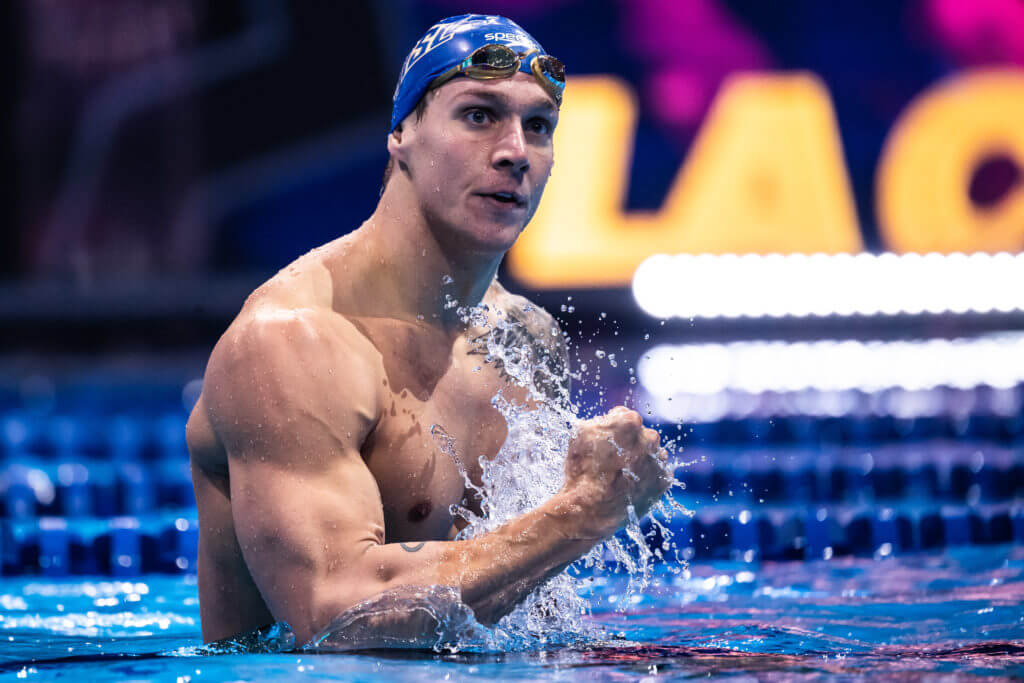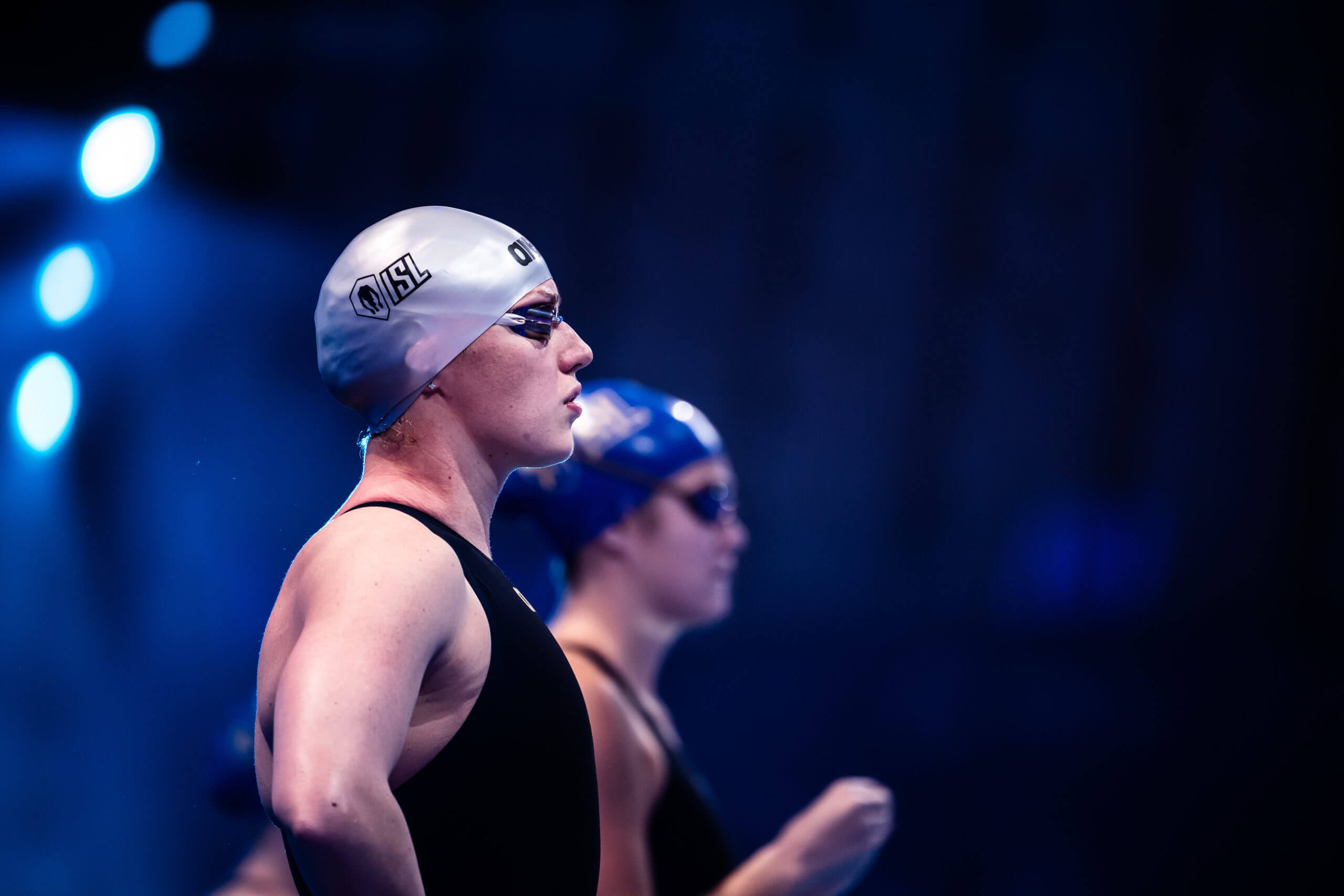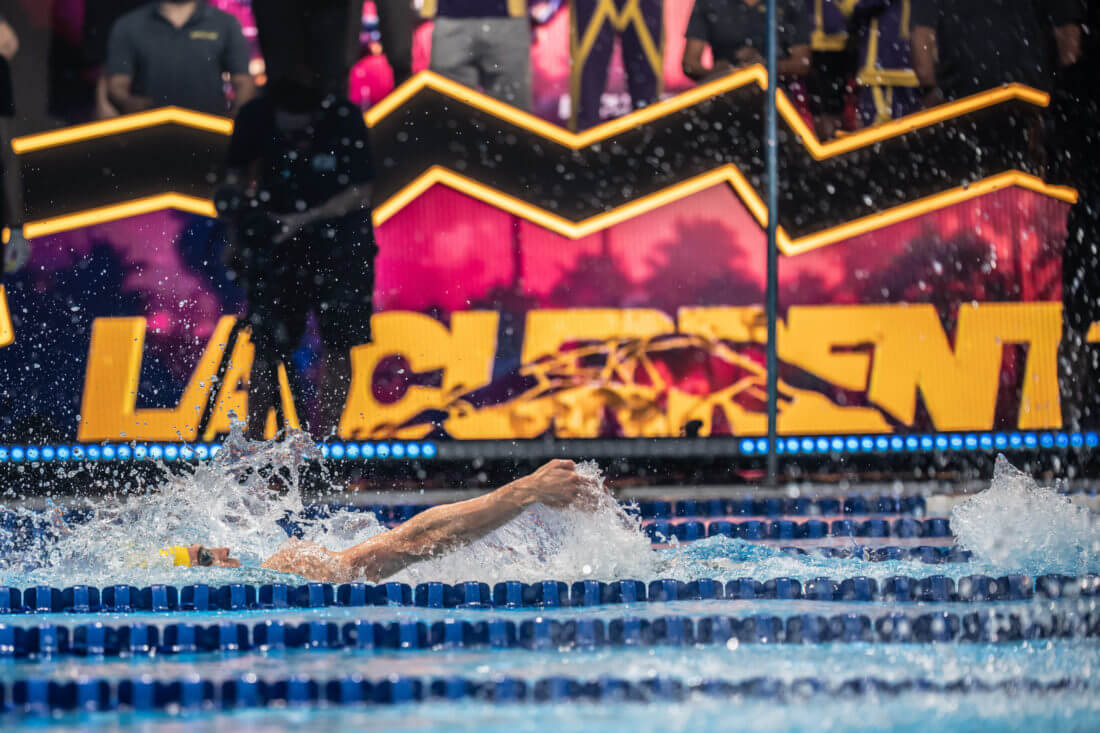ISL Semifinal 2 Notes: An Ode to Caeleb Dressel as Identical Grand Final Looms

Words fail for what Caeleb Dressel did in the 100 individual medley in ISL Semifinal 2 Monday.
About the time that Dressel hit the 50-meter wall, the other seven swimmers – all elite, mind you – a body length back, you got the sense that something special was in store.
When Dressel hit the wall and the assault of numbers hit the screen, it was hard to pick which was most impressive.
Was it 49.88, the first men’s 100-meter short-course IM to break the delightfully round 50-second mark?
Was it the 30 points next to his name, the largest jackpot of the ISL season, sweeping all but his teammate’s second-place points?
Those are the kinds of conundrums Dressel’s speed forces you into. He didn’t just break the world record of Vlad Morozov, interloping in an event where Morozov had, before this season, held the top 10 times in history. He smashed it by nearly four tenths of a second, a monstrous margin in such a short distance and further validation for the event’s addition to the ISL program for Season 2.
Dressel’s record had a knock-on effect for a Cali Condors team that ran away with the win, undefeated in five matches this season. With 605.5 points, it was the fifth-highest winning total in 12 matches this season, easily outdistancing the LA Current in their third meeting of the season, plus Team Iron and the Toronto Titans.
“It did a lot for me,” Hali Flickinger said during a virtual mixed zone after ISL Semifinal 2. “I can’t really speak for everybody, but I’m sure everybody was really pumped after that. I was in the warmup pool warming down from my 2-fly and I was ready to go after that. That was awesome. It’s so cool to see it. It’s infectious. Seeing that, you want to get up and do as much as you can for the team.”
The 100 IM was among three American records Dressel set Monday. In the 50 butterfly and the 100 freestyle, the margins were less emphatic, just .02 seconds in both. But they improved times he set at the Grand Final last year, indicating just how much faster he might be this time around, with one more match to improve his speed and maybe bring the Condors the league crown.
A tribute to the Iron Lady

Katinka Hosszu during ISL Semifinal 2; Photo Courtesy: MIKE LEWIS / ISL
Katinka Hosszu didn’t have the ISL season she might have hoped for, which is less an indictment of her performance than praise for the lofty standards she has set over the last decade.
The Team Iron star/namesake won just (“just”) three events this year after claiming nine individual wins in 2019, three apiece in the 200 fly, 200 IM and 400 IM. In ISL Semifinal 2, she scored 15 points, good for 42nd in the MVP standings, a spot usually reserved for mortals who don’t have four Olympic medals and 42 World Championships medals on their CVs.
But as Rowdy Gaines alluded to on the broadcast, Hosszu has meant so much more to the International Swimming League than just what she’s done in the pool during its second season. The fact that the league got off the ground owed in part of her putting her stardom behind it and encouraging other swimmers to. The Budapest setting for this most unprecedented of events, thus far successful even as global COVID-19 cases surge, owes in part to her magnetism. Heck, even Dressel, for all his might, doesn’t have a team named after him.
“I think the real friendship began during ISL,” Team Iron sprinter Ranomi Kromowidjojo said of Hosszu, who she’s known since 2005. “It began last year, but this year was really special. I think being part of the bubble and six weeks being so close together, we really grew into a really great friendship. I talked a lot with Katinka about swimming, about life, about all kinds of stuff and it’s definitely a really nice friend to have. I have a lot of fun with Katinka.”
Hosszu will be 32 by the time the 2021 Olympics start. Her expansive program, barely believable for someone in their prime, certainly will be culled. This is hardly a valedictory season for an icon of the sport, but rather a chance to reflect. Even if Hosszu never swims in another Olympic final, her mark on swimming will be one of the most profound of her generation.
Meet the new finalists …

Ryan Murphy; Photo Courtesy: MIKE LEWIS / ISL
The 2020 Grand Final will have the same finalists as the 2019 Grand Final. Energy Standard and London Roar are the pick of the global division. LA Current and Cali Condors emerge from the five North American teams via ISL Semifinal 2. Through two rounds of expansion, the bubble format, additions of the jackpot and alterations in the skins format … it’s still the same.
For a club like the LA Current, which finished fourth in the Grand Final last year, withstanding the added competition to get back is a notable accomplishment.
“Getting into the final was really what we wanted,” Current ISL rookie Helena Gasson said. “We came here to get as close to winning or win, that’s basically what the goal was from the start. To be in the final and to have that opportunity is pretty awesome, especially because this is my first ISL season, it’s really exciting.”
This isn’t a value judgment on whether parity or a lack thereof suits a nascent league. It’s without controversy in the pool, since the watch tells the tale dispassionately. The ISL is a star-driven league, and the stars of each of the finalists are more synonymous than their teams than any of the six teams leaving the bubble early (Hosszu and Kromowidjojo for Team Iron the exception).
The 2021 season will present a challenge on that front. Swimmers typically take time off following the Olympics. An extra year added to the cycle might exacerbate that, and star-driven squads might be at a disadvantage if their top-billed swimmer opts out. ISL might also, if conditions surrounding COVID-19 (mercifully) improve, be a deeper league next year, with the return of certain European federations and the sizeable Australian contingent that sat out this year, plus a handful of notable North American names. The league is already better for the influx of Japanese swimmers via the Tokyo Frog Kings; could penetration of the Chinese market be next? This year’s consensus rookie of the year, Emre Sakci, hails from noted swimming powerhouse Turkey. Other teams have been driven by young swimmers emerging surprisingly. What other swimming talent could emerge in an Olympic year and be drawn in by the magnet of ISL?
That’s all for down the road. For now, perhaps it’s enough to say that the four two-time finalists have set the blueprint. Team Iron, Tokyo, Toronto, Aqua Centurions on the men’s side, all have the makings to challenge for a finals spot in Season 3. Each of the six non-finalists will have to assess their needs and build accordingly. That’s the way the four finalists got here.
.jpg)
- ISL WEBSITE
- SEASON 2 SCHEDULE
- EUROPEAN ROSTERS
- AMERICAN ROSTERS
- TOKYO & TORONTO NEW ROSTERS
- CBS TV AGREEMENT
- MATCH ONE RESULTS (CONDORS, ENERGY, CURRENT, BREAKERS)
- MATCH TWO RESULTS (ROAR, IRON, TRIDENT, CENTURIONS)
- MATCH THREE RESULTS (CURRENT, FROG KINGS, TITANS, CENTURIONS)
- MATCH FOUR RESULTS (CONDORS, IRON, BREAKERS, TRIDENT)
- MATCH FIVE RESULTS (ROAR, CURRENT, FROG KINGS, TRIDENT)
- MATCH SIX RESULTS (ENERGY, TITANS, BREAKERS, CENTURIONS)
- MATCH SEVEN RESULTS (ENERGY, IRON, TITANS, TRIDENT)
- MATCH EIGHT RESULTS (CONDORS, ROAR, FROG KINGS, BREAKERS)
- MATCH NINE RESULTS (ENERGY, FROG KINGS, IRON, TITANS)
- MATCH TEN RESULTS (CONDORS, CURRENT, ROAR, CENTURIONS)
- SEMI ONE RESULTS
- SEMI TWO RESULTS
- GRAND FINAL RESULTS



